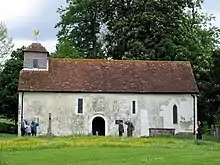All Saints Church, Little Somborne
All Saints' Church is a redundant Church of England parish church in the hamlet of Little Somborne, Hampshire, England. It is a Grade II* listed building in the National Heritage List for England[1] and is under the care of the Churches Conservation Trust.[2] The church is about 4 miles (6 km) southeast of Stockbridge, east of the A3057 road.[2][3]
| All Saints Church, Little Somborne | |
|---|---|
 All Saints' Church, Little Somborne, from the south | |
 All Saints Church, Little Somborne Location in Hampshire | |
| 51.0919°N 1.4557°W | |
| OS grid reference | SU 383 326 |
| Location | Little Somborne, Hampshire |
| Country | England |
| Denomination | Church of England |
| Website | Churches Conservation Trust |
| Architecture | |
| Functional status | Redundant |
| Heritage designation | Grade II* |
| Designated | 29 May 1957 |
| Architectural type | Church |
| Style | Anglo-Saxon, Norman |
| Specifications | |
| Materials | Rendered flint rubble with stone dressings Tiled roof |
History
The oldest parts of the church are Anglo-Saxon. It is recorded in the Domesday Book. The original church had a nave and a chancel, but in 1170 the chancel was removed, the nave was extended towards the east, and a very small chancel was added at the east end.[2] The chancel was removed in the 17th century, the chancel arch was filled in with a wall and a window was inserted.[1]
Architecture
The church is built of flint rubble with stone dressings. The walls are rendered and colourwashed. The roof is tiled.[1] Its plan is simple, consisting of a nave and a chancel in a single range, with a weatherboarded bellcote at the west end. At the east end, within the former chancel arch, is a three-light square-headed window, and above this are two lancet windows. In the north wall of the chancel is a 12th-century single-light window. West of this is a blocked door dating from the same period. Also in the north wall is an Anglo-Saxon pilaster strip made in Binstead stone from the Isle of Wight. In the south wall of the chancel is a 13th-century lancet window. West of this are two single-light square-headed windows. Between these is a Norman round-headed doorway. The west window is 14th-century and has two lights with trefoil heads, and there is a quatrefoil window above it.[4]
The plaster has been stripped from the interior side of the walls, and the floor has been partly removed and replaced by flagstones. South of the chancel arch is a small round-headed niche. The font is 19th-century.[1]
Churchyard
In the churchyard is the grave of Thomas Sopwith (1888–1989), the pioneer aviator, aircraft manufacturer and yachtsman.[2]
References
- Historic England, "Church of All Saints (Grade II*) (1167714)", National Heritage List for England, retrieved 27 June 2013
- All Saints' Church, Little Somborne, Hampshire, Churches Conservation Trust, retrieved 25 March 2011
- Little Somborne, Streetmap, retrieved 22 March 2011
- Page, William, ed. (1911). "Little Somborne". A History of Hampshire and the Isle of Wight. Victoria County History. Vol. IV. London: Archibald Constable & Co. pp. 480–482. ISBN 978-0712905947 – via British History Online.
External links
- Meehan, Barry (27 January 2014). "All Saints, Little Somborne". Hampshire Churches. Archived from the original on 27 January 2014. – detailed architectural description
- "Little Somborne, Hampshire – All Saints Church". Astoft. – photographs of the exterior and interior
- Vigar, John. "All Saints Little Somborne". Hampshire Churches. – photographs